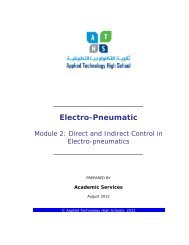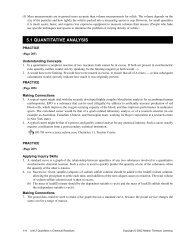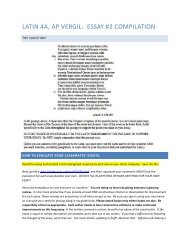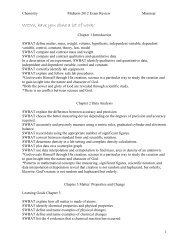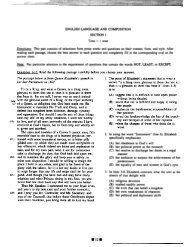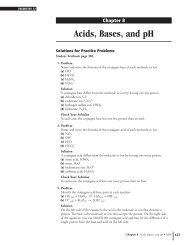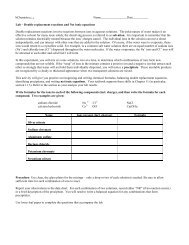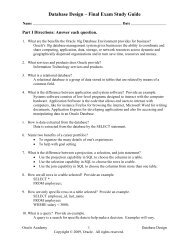Sol Equil KEY - Quia
Sol Equil KEY - Quia
Sol Equil KEY - Quia
You also want an ePaper? Increase the reach of your titles
YUMPU automatically turns print PDFs into web optimized ePapers that Google loves.
Student Performance Q&A:<br />
2006 AP ® Chemistry Free-Response Questions<br />
The following comments on the 2006 free-response questions for AP ® Chemistry were written by<br />
the Chief Reader, Eleanor Siebert of Mount St. Mary’s College in Los Angeles, California. They<br />
give an overview of each free-response question and of how students performed on the question,<br />
including typical student errors. General comments regarding the skills and content that students<br />
frequently have the most problems with are included. Some suggestions for improving student<br />
performance in these areas are also provided. Teachers are encouraged to attend a College Board<br />
workshop to learn strategies for improving student performance in specific areas.<br />
Question 1<br />
What was the intent of this question?<br />
This question was a required equilibrium problem designed to assess students’ understanding of solubility<br />
and principles of solubility equilibrium. Students were expected to write an expression for the K sp from<br />
the solubility equation, determine the stoichiometric relationship between concentrations of ions, and<br />
calculate the value of the K sp . They were asked to assess the effect of different volumes of solution on the<br />
concentrations of ions in a saturated solution and the effect of adding a soluble salt containing a common<br />
ion. The last part of the question assessed students’ ability to calculate concentrations of ions from<br />
dilution data and to calculate and interpret the value of Q in comparison to K . sp<br />
How well did students perform on this question?<br />
Students did a good job answering the question, earning a mean score of 4.19 out of a possible 9 points.<br />
There was a very flat score distribution, with each score (0–9) accounting for 8 to 12 percent of the<br />
responses (excluding blanks). The comparatively large percentage of 8s and 9s indicated that many<br />
students had mastered the tested concepts. The points were well distributed among the four parts of the<br />
problem, though many responses that scored in the midrange (5–6) earned most of the points on parts (a)<br />
and (d). Students who earned 1–3 points usually earned them in part (a). Part (b) was the most challenging<br />
for students; most of the students who earned 8 points failed to earn the 1 point for part (b).<br />
1<br />
© 2006 The College Board. All rights reserved.<br />
Visit apcentral.collegeboard.com (for AP professionals) and www.collegeboard.com/apstudents (for students and parents).



